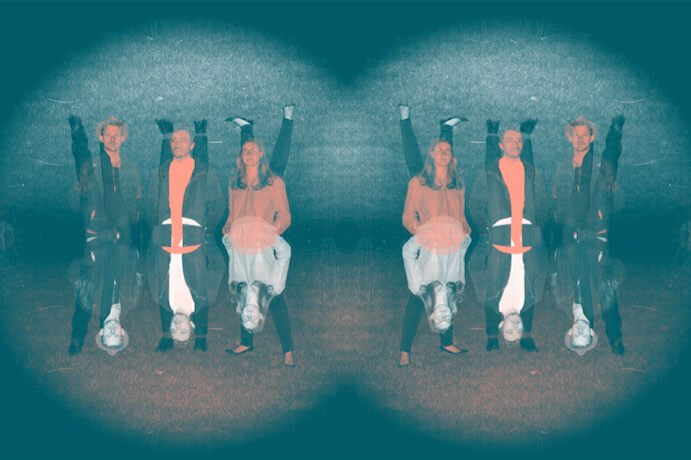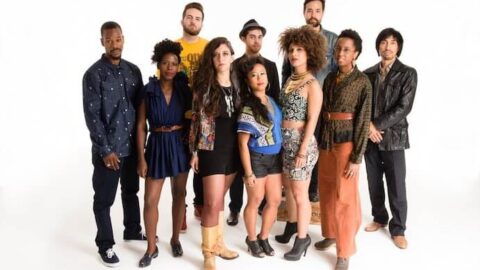On June 2, 2017, Brooklyn’s contemporary music sanctuary National Sawdust cleared away the chairs and set the stage for an evening of movement and revelry, driven by the introspective and at times entrancingly iridescent beats of drum-percussion trio Tigue. Tigue, comprised of equal parts Matt Evans, Amy Garapic, and Carson Moody, were joined by the trance-inducing responsorials of Moroccan musical collective Innov Gnawa and the show-stopping energy of the self-described “NY born female-fronted group of modern afrobeat deconstructionists” known as Underground System.
Throughout the night, a hovering, transcendent resonance permeated the hall, unified by a stated mission shared by all the performers that those in attendance should lose themselves in the evocation of a musical trance, and most importantly, dance their butts off. Unfortunately, there seemed to be an imbalance in understanding this proclamation that caused the casual nonchalance expressed by a sufficient portion of the assembled crowd to frequently cross the line from participatory fun to disruption and apparent disregard. Positioned at the corner of National Sawdust’s trapezoidal lobby nearest the garage door-like entrance to the hall, the ongoing activity of the bar blurred the division between the formless and chaotic outside world and the focused energy of the performance space. Noisy chit-chat persisted throughout the set, as transient concertgoers continued to catch up with old friends and make introductions between strangers while they wandered into the hall seemingly unaware that the performance was underway. Nonetheless, Tigue played their hearts out with a quality unchallenged by this faction of oblivious attendees whose motivation for coming to the show remained unclear.
The band was dressed in vivid costumes right down to an exciting array of colorful socks. A veritable kaleidoscope to behold, their physical appearance could be taken in as a kind of synesthetic metaphor for the pulsating, prismatic spectrum of crystalline tones and delicately energetic beats and polyrhythms they produced. Seated facing one another in a triangular formation, each behind a drum kit, Tigue proceeded to emanate as if by second nature the group’s self-described oeuvre of “kinetic and hypnotic…instrumental minimalism.”

Produced at times in an almost ritualistic manner, these are sounds that deserve to be carefully and attentively listened to and not just bopped along or treated like background dance hall entertainment. In once instance, Carson Moody stepped away from his kit and produced an array of laser-like, ringing tones by drawing his forefinger and thumb along various lengths of metal rods. Over currents and waves of pressing rhythms maintained by Evans and Garapic, it was a moment during which time expanded across a new dimension and induced gaping jaws and delighted ears. A moment during which even those encouraged to dance (or those who hadn’t yet seen past the rims of their beer glasses) might have passed into a state of suspended animation to consider the depth of artistry this trio of talented composer-performers may have the luxury of taking for granted.
While Tigue’s unique compositions and performance practice characteristically approach a ritual aesthetic, Innov Gnawa’s repertoire descends directly from the ritual world of devotional music. Gnawa are Islamic spirituals peculiar to Morocco’s black communities with roots reaching back to “slaves and soldiers once brought to Morocco from Northern Mali and Mauritania,” as explained on Innov Gnawa’s website. The music is performed by groups of devotees under the guidance of a Maâlem or master musician who vocalizes the melodies with the assistance of a stringed instrument called a sintir, accompanied by ecstatic rhythms and movement marked by iron castanets known as qarqaba.
Under the expert leadership of Maâlem Hassan Ben Jaafer, who hails from Fez, Morocco, Innov Gnawa emerged between Tigue’s opening and main sets, dressed in flowing robes capped by headdresses decorated with cowrie shells, qarqaba clapping and songs vaulting into an atmosphere freshly charged with spiritual energy. The music itself was an energetic repetition of phrases and patterns, its meaning conveyed by Arabic texts descanted by Jaafer and echoed in chorus by the gentlemen of the ensemble. Jaafer strummed along on his sintir, singing lusciously, his face emanating a sublime and aristocratic disposition. There were moments during which cartoony ululations emanated from a portion of the audience (many of whom had previously talked over Tigue’s thoughtful performance), perhaps innocently inspired by the exoticism of the music. In the moment, these outbursts felt somewhat inappropriate, a feeling that abated as the ensemble continued to incite an expanding revelry.

Welcome moments of lucidity came as attending Moroccans and attentive concertgoers entered into the inspiring world of Innov Gnawa’s tradition. Indeed, the excitement and happiness of those who seemed to understand the words and who moved with comprehension all but neutralized any reactionary negativity toward those whose more impulsive actions tipped slightly toward cultural insensitivity. The result instilled a more virtuous mood, free of judgement; that this music is for everyone, and should be experienced and enjoyed in one’s own manner.
Following a raucous ovation for Innov Gnawa, which the ensemble welcomed with beaming smiles, Tigue returned to the stage to premiere a new, thirty-minute composition that offered even further insight into the group’s joyous effervescence and that seemed to resonate with the lingering ecstasy of Innov Gnawa’s chants. Finally, Underground System took over and managed to broker the transmutation of all aspects of the night’s energy into an engaging tapestry of positive, undiscriminating vibes, welcoming to all and at the top of their game.
In all, these three wonderfully diverse and engaging groups provided a spectrum of sounds and philosophies that left no choice but to be celebrated, and no matter how engaged or in what manner, welcomed all into a unique and transformative musical dimension.
























